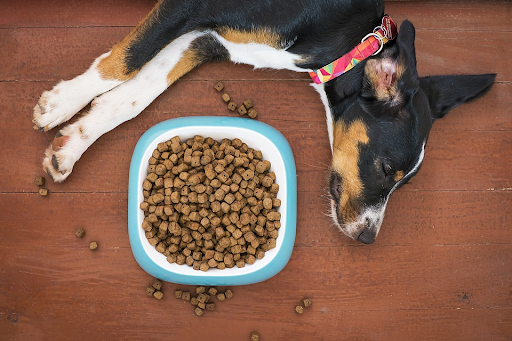Dogs can be a lot like children in their eating habits. They gobble down the food as quickly as possible, which is not good for their digestion or future health. However, there are many things you can do to train them to eat more slowly and with consideration for what they’re consuming. Here are four of the most popular ways:
1) Place Dry Food In A Slow Feed Bowl
The idea behind this technique is that dogs may feel compelled to chew while it’s falling out of the hole in the middle of their dish; therefore, they will end up taking longer than usual because they have to wait for it to drop through before getting another mouthful. Using a high-quality Slow Feeder Dog Bowl can help drastically to stop your dog from eating too quickly. If your dog doesn’t like putting its head into an upturned bowl, then the following slow feeder bowls are suitable alternatives.
A slow feed bowl can take up to 30 minutes for a dog to eat all the food within, meaning you won’t need to go back and feed them again if they decide not to finish eating. Another benefit is that it prevents bad doggy breath since dogs tend not to chew as much on the food when there is no competition with other dogs around.
2) Feed Dry Food Near The Ground
Similar to number 1, this method is based on the fact that dogs may feel like they need to chew their kibble as it hits the floor. They won’t know where it’s going to land, so they might eat slower than usual to be sure of getting every piece. However, you should only do this if your dog will not try to reach for food dropped on the floor because certain pieces can be picked up more easily than others, resulting in an unbalanced diet.
Eating on the floor not only encourages healthy paw care but also helps in digestion in dogs that overeat or wolf down their food. They can eat smaller portions more frequently since it’s too hard to pick up large piles of kibble! Try it out with your dog today!
3) Grate Or Chop Food Before Serving
You can use a grater or even just a pair of sharp scissors to break up your dog’s food into smaller pieces. This will encourage them to chew the pieces more thoroughly before swallowing them, and it is thought that this may also allow their stomach to digest food at a slower pace, which is good for them in the long run.
Dogs will need to spend more time chewing and digesting smaller pieces of food than if they’d just chowed down on a large piece. This is because there is less surface area for bacteria to cling to, and it won’t be as tough on their teeth too!
If you’re somebody with two dogs, then this tip might sound familiar: You can buy one big bag of dog food and then use the bread maker machine at home to make kibbles out of the same batch. It’s cheaper that way, plus your little furry friends are likely going to love you even more.
4) Split Meals Into Multiple Feedings
Rather than leaving your dog’s meal out all day, split it up into several small portions throughout the day. If they are only given access to dry food once or twice per day, then there’s less chance of an upset stomach as they will not be overeating on carbs and sugars too frequently. Although dogs with sensitive stomachs should ideally be fed little and often regardless of how much they eat at one sitting.
With the latest trend in the owner-dog relationship being to split a single dog’s meal into multiple feedings, many people may not think that this is an important issue. This can, however lead to health problems for your dog if they’re not fed on time, and it can lead to dominance issues and other behavioral problems; one of the key benefits of feeding your dogs multiple times a day is that you can adjust their diet to match their needs based on life stage and health conditions. It also ensures that your pup isn’t feeling too full all at once, leading to them overeating and vomiting or having gastrointestinal distress.

Dogs are notoriously known for gobbling down their food too quickly, which can lead to digestive problems in the future. However, there are many things you can do to train your dog to eat more slowly and with consideration for what they’re consuming. We hope that the 4 methods we have provided should be enough of a starting point!
Published on Holr Magazine


